Engage NY Eureka Math 7th Grade Module 6 Lesson 23 Answer Key
Eureka Math Grade 7 Module 6 Lesson 23 Example Answer Key
Example 1.
a. Calculate the surface area of the rectangular prism.
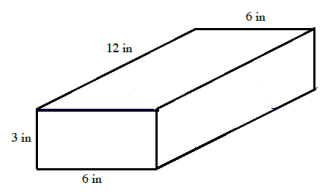
b. Imagine that a piece of the rectangular prism is removed. Determine the surface area of both pieces.

c. How is the surface area in part (a) related to the surface area in part (b)?
Answer:
a. Surface area:
2(3 in. × 6 in.) + 2(3 in. × 12 in.) + 2(6 in. × 12 in.)
= 2(18 in2) + 2(36 in2) + 2(72 in2 )
= 36 in2 + 72 in2 + 144 in2
= 252 in2
b. 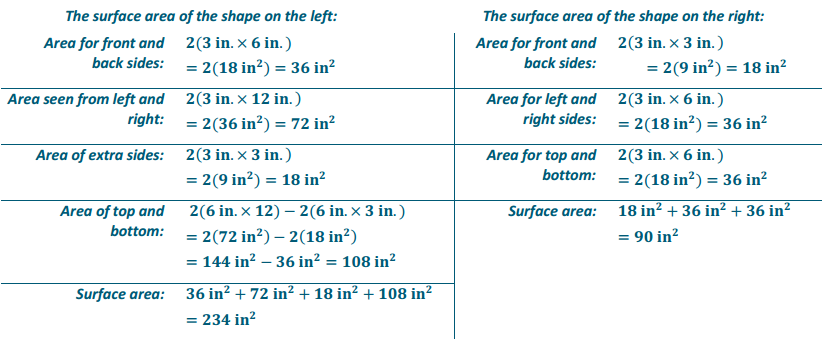
→ How did you determine the surface area of the shape on the left?
→ I was able to calculate the area of the sides that are rectangles using length times width. For the two bases that are C – shaped, I used the area of the original top and bottom and subtracted the piece that was taken off.
c. If I add the surface area of both figures, I will get more than the surface area of the original shape.
234 in2 + 90 in2 = 324 in2
324 in2 – 252 in2 = 72 in2
72 in2 is twice the area of the region where the two pieces fit together.
There are 72 more square inches when the prisms are separated.
Eureka Math Grade 7 Module 6 Lesson 23 Exercise Answer Key
Opening Exercise
Calculate the surface area of the square pyramid.

Answer:
Area of the square base:
s2 = (8 cm)2
= 64 cm2
Area of the triangular lateral sides:
\(\frac{1}{2}\) bh = \(\frac{1}{2}\)(8 cm)(5 cm)
= 20 cm2
There are four lateral sides. So, the area of all 4 triangles is 80 cm2.
Surface area:
(8 cm ∙ 8 cm) + 4(1/2 (8 cm ∙ 5 cm)) = 64 cm2 + 80 cm2 = 144 cm2
→ Explain the process you used to determine the surface area of the pyramid.
Answers will vary. I drew a net to determine the area of each side and added the areas together.
→ The surface area of a pyramid is the union of its base region and all its lateral faces.
→ Explain how (8 cm ∙ 8 cm) + 4(\(\frac{1}{2}\)(8 cm∙5 cm)) represents the surface area.
The area of the square with side lengths of 8 cm is represented by (8 cm ∙ 8 cm), and the area of the four lateral faces with base lengths of 8 cm and heights of 5 cm is represented by 4(\(\frac{1}{2}\) (8 cm∙5 cm)).
→ Would this method work for any prism or pyramid?
Answers will vary. Calculating the area of each face, including bases, will determine the surface area even if the areas are determined in different orders, by using a formula or net, or any other method.
Determine the surface area of the right prisms.
Exercise 1.
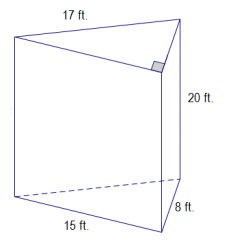
Answer:
Area of top and bottom: 2(\(\frac{1}{2}\)(15 ft. × 8 ft.) )
= 15 ft. × 8 ft. = 120 ft2
Area of front: 15 ft. × 20 ft. = 300 ft2
Area that can be seen from left: 17 ft. × 20 ft. = 340 ft2
Area that can be seen from right: 8 ft. × 20 ft. = 160 ft2
Surface area: 120 ft2 + 300 ft2 + 340 ft2 + 160 ft2 = 920 ft2
Exercise 2.
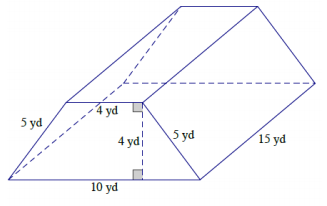
Answer:
Area of front and back: 2(\(\frac{1}{2}\)(10 yd. + 4 yd.)4 yd.)
= 14 yd. × 4 yd. = 56 yd2
Area of top: 4 yd. × 15 yd. = 60 yd2
Area that can be seen from left and right: 2(5 yd. × 15 yd.)
= 2(75 yd2) = 150 yd2
Area of bottom: 10 yd. × 15 yd. = 150 yd2
Surface area: 56 yd2 + 60 yd2 + 150 yd2 + 150 yd2 = 416 yd2
Exercise 3.
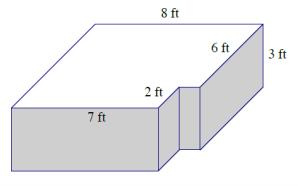
Answer:
Area of top and bottom: 2((8 ft. × 6 ft.) + (7 ft. × 2 ft.))
= 2(48 ft2 + 14 ft2 )
= 2(62 ft2 ) = 124 ft2
Area for back: 8 ft. × 3 ft. = 24 ft2
Area for front: 7 ft. × 3 ft. = 21 ft2
Area of corner cutout: (2 ft. × 3 ft.) + (1 ft. × 3 ft.) = 9 ft2
Area of right side: 6 ft. × 3 ft. = 18 ft2
Area of left side: 8 ft. × 3 ft. = 24 ft2
Surface area: 124 ft2 + 24 ft2 + 21 ft2 + 9 ft2 + 18 ft2 + 24 ft2 = 220 ft2
Exercise 4.

Answer:
Surface area of top prism:
Area of top: 4 m × 5 m = 20 m2
Area of front and back sides: 2(4 m × 5 m) = 40 m2
Area of left and right sides: 2(5 m × 5 m) = 50 m2
Total surface area of top prism: 20 m2 + 40 m2 + 50 m2 = 110 m2
Surface area of bottom prism:
Area of top: 10 m × 10 m – 20 m2 = 80 m2
Area of bottom: 10 m × 10 m = 100 m2
Area of front and back sides: 2(10 m × 3 m) = 60 m2
Area of left and right sides: 2(10 m × 3 m) = 60 m2
Total surface area of bottom prism: 80 m2 + 100 m2 + 60 m2 + 60 m2
= 300 m2
Surface area: 110 m2 + 300 m2 = 410 m2
Exercise 5.
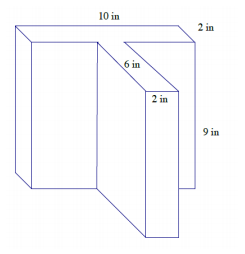
Answer:
Area of top and bottom faces: 2(10 in. × 2 in.) + 2(6 in. × 2 in.)
= 40 in2 + 24 in2
= 64 in2
Area of lateral faces: 2(9 in. × 2 in.) + 2(6 in. × 9 in.) + 2(9 in. × 10 in.)
= 36 in2 + 108 in2 + 180 in2
= 324 in2
Surface area:
64 in2 + 324 in2 = 388 in2
Eureka Math Grade 7 Module 6 Lesson 23 Problem Set Answer Key
Determine the surface area of the figures.
Question 1.

Answer:
Area of top and bottom: 2(9 cm × 4 cm) = 72 cm2
Area of left and right sides: 2(4 cm × 9 cm) = 72 cm2
Area of front and back: 2(9 cm × 4 cm) + 2(4.5 cm × 5 cm)
= 117 cm2
Surface area: 72 cm2 + 72 cm2 + 117 cm2 = 261 cm2
Question 2.
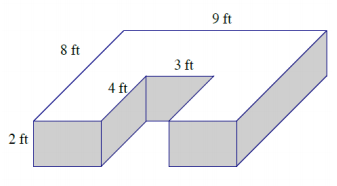
Answer:
Area of front and back: 2(9 ft. × 2 ft.) = 36 ft2
Area of sides: 2(8 ft. × 2 ft.) = 32 ft2
Area of top and bottom: 2(9 ft. × 8 ft.) – 2(4 ft. × 3 ft.)
= 144 ft2 – 24 ft2
= 120 ft2
Area of interior sides: 2(4 ft. × 2 ft.) = 16 ft2
Surface area: 36 ft2 + 32 ft2 + 120 ft2 + 16 ft2 = 204 ft2
Question 3.

Answer:
Surface area of top prism:
Area of top: 8 in. × 6 in. = 48 in2
Area of front and back sides: 2(6 in. × 8 in.) = 96 in2
Area of left and right sides: 2(8 in. × 8 in.) = 128 in2
Total surface area of top prism: 48 in2 + 96 in2 + 128 in2 = 272 in2
Surface area of bottom prism:
Area of top: 16 in. × 16 in. – 48 in2 = 208 in2
Area of bottom: 16 in. × 16 in. = 256 in2
Area of front and back sides: 2(16 in. × 4 in.) = 128 in2
Area of left and right sides: 2(16 in. × 4 in.) = 128 in2
Total surface area of bottom prism: 208 in2 + 256 in2 + 128 in2 + 128 in2
= 720 in2
Surface area: 272 in2 + 720 in2 = 992 in2
Question 4.
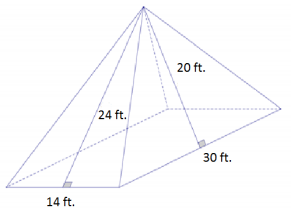
Answer:
Area of the rectangle base: 14 ft. × 30 ft. = 420 ft2
Area of the triangular lateral sides:
Area of front and back: \(\frac{1}{2}\)bh
= 2(\(\frac{1}{2}\)(14 ft.)(24 ft.))
= 336 ft2
Area that can be seen from left and right: \(\frac{1}{2}\)bh
= 2(1\(\frac{1}{2}\)(30 ft.)(20 ft.))
= 600 ft2
Surface area: 420 ft2 + 336 ft2 + 600 ft2 = 1,356 ft2
Question 5.
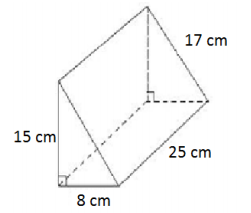
Answer:
Area of front and back: 2(\(\frac{1}{2}\)(8 cm × 15 cm))
= 8 cm × 15 cm
= 120 cm2
Area of bottom: 8 cm × 25 cm
= 200 cm2
Area that can be seen from left side: 25 cm × 15 cm
= 375 cm2
Area that can be seen from right side: 25 cm × 17 cm
= 425 cm2
Surface area: 120 cm2 + 200 cm2 + 375 cm2 + 425 cm2 = 1,120 cm2
Eureka Math Grade 7 Module 6 Lesson 23 Exit Ticket Answer Key
Determine and explain how to find the surface area of the following right prisms.
Question 1.

Answer:
Area of top and bottom: 2(\(\frac{1}{2}\)(12 ft. × 5 ft.))
= 12 ft. × 5 ft.
= 60 ft2
Area of front: 12 ft. × 15 ft.
= 180 ft2
Area seen from left: 13 ft. × 15 ft.
= 195 ft2
Area seen from right: 5 ft. × 15 ft.
= 75 ft2
Surface area: 60 ft2 + 180 ft2 + 195 ft2 + 75 ft2
= 510 ft2
To find the surface area of the triangular prism, I must sum the areas of two triangles (the bases that are equal in area) and the areas of three different – sized rectangles.
Question 2.
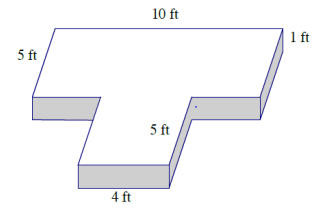
Answer:
Area of front and back: 2(10 ft. × 1 ft.) = 20 ft2
Area of sides: 2(10 ft. × 1 ft.) = 20 ft2
Area of top and bottom: 2(10 ft. × 5 ft.) + 2(4 ft. × 5 ft.)
= 100 ft2 + 40 ft2
= 140 ft2
Surface area: 20 ft2 + 20 ft2 + 140 ft2
= 180 ft2
To find the surface area of the prism, I must sum the composite area of the bases with rectangular areas of the sides of the prism.